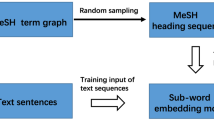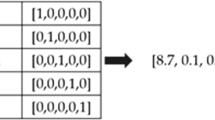Abstract
Word embeddings have been widely used in lexical semantics and neural networks in Natural Language Processing. This article investigates the semantic representations using word embedding technologies by verifying them on a human constructed domain ontology. The domain of Traditional Chinese Medicine (TCM) is used as a workbench in this study, because this domain is knowledge-rich and has a large-scale domain ontology with well-defined entity types and relation types. This article releases a dataset, named “TCMSem”, to capture TCM domain experts’ intuitions of semantic relatedness. This data set is designed to cover the medical entities and relations with as many semantic types as possible so as to initiate a diverse and comprehensive evaluation on word embeddings. Experimental results show that word embeddings have demonstrated higher proficiencies in the detection of synonyms and collocations than other types of semantic relations. Furthermore, the semantic relatedness of thousands of terms of major categories in TCM is visualized using the taxonomy defined in the ontology.
Access this chapter
Tax calculation will be finalised at checkout
Purchases are for personal use only
Similar content being viewed by others
References
Joulin, A., Grave, E., Bojanowski, P., Mikolov, T.: Bag of tricks for efficient text classification, arXiv preprint arXiv:1607.01759
Li, J., Monroe, W., Ritter, A., Galley, M., Gao, J., Jurafsky, D.: Deep reinforcement learning for dialogue generation, arXiv preprint arXiv:1606.01541
Klein, G., Kim, Y., Deng, Y., Senellart, J., Rush, A.M., OpenNMT: open-source toolkit for neural machine translation, arXiv preprint arXiv:1701.02810
Lin, Y., Liu, Z., Sun, M., Liu, Y., Zhu, X.: Learning entity and relation embeddings for knowledge graph completion, In: AAAI, vol. 15, pp. 2181–2187 (2015)
Li, S., Zhao, Z., Hu, R., Li, W., Liu, T., Du, X.: Analogical reasoning on chinese morphological and semantic relations. In: ACL 2018 (2018)
Bodenreider, O.: The unified medical language system (UMLS): integrating biomedical terminology. Nucl. Acids Res. 32(suppl\(\_\)1), D267–D270 (2004)
McCray, A.T.: The UMLS semantic network. In: Proceedings, Symposium on Computer Applications in Medical Care, American Medical Informatics Association, pp. 503–507 (1989)
Chen, H., et al.: Towards a semantic web of relational databases: a practical semantic toolkit and an in-use case from traditional Chinese medicine. In: Cruz, I., et al. (eds.) ISWC 2006. LNCS, vol. 4273, pp. 750–763. Springer, Heidelberg (2006). https://doi.org/10.1007/11926078_54
Wang, Y., Yu, Z., Jiang, Y., Xu, K., Chen, X.: Automatic symptom name normalization in clinical records of traditional Chinese medicine. BMC Bioinform. 11(1), 40 (2010)
Wu, Z., Chen, H., Jiang X.: Modern Computational Approaches to Traditional Chinese Medicine. Elsevier (2012)
Gu, P., Chen, H., Yu, T.: Ontology-oriented diagnostic system for traditional Chinese medicine based on relation refinement. In: Computational and Mathematical Methods in Medicine (2013)
Ruan, T., et al.: An automatic approach for constructing a knowledge base of symptoms in Chinese. J. Biomed. Semant. 8(1), 33 (2017)
Ballatore, A., Bertolotto, M., Wilson, D.C.: An evaluative baseline for geo-semantic relatedness and similarity. GeoInformatica 18(4), 747–767 (2014)
Cui, M., et al.: Current status of traditional Chinese medicine language system. In: Li, Shaozi, Jin, Qun, Jiang, Xiaohong, Park, James J.(Jong Hyuk) (eds.) Frontier and Future Development of Information Technology in Medicine and Education. LNEE, vol. 269, pp. 2287–2292. Springer, Dordrecht (2014). https://doi.org/10.1007/978-94-007-7618-0_280
Yu, T., Cui, M., Li, H.-Y., et al.: Semantic network framework of traditional Chinese medicine language system: an upper-level ontology for traditional Chinese medicine. China Digit. Med. 9, 44–47 (2014)
Harris, Z.: Distributional structure. Word 10(23), 146–162 (1954)
Mikolov, T., Sutskever, I., Chen, K., Corrado, G.S., Dean, J.: Distributed representations of words and phrases and their compositionality. In: Advances in Neural Information Processing Systems, pp. 3111–3119 (2013)
Pennington, J., Socher, R., Manning, C.: Glove: global vectors for word representation. In: Proceedings of the 2014 Conference on Empirical Methods in Natural Language Processing (EMNLP), pp. 1532–1543 (2014)
Bojanowski, P., Grave, E., Joulin, A., Mikolov, T.: Enriching word vectors with subword information, arXiv preprint arXiv:1607.04606
Peters, M.E., et al.: Deep contextualized word representations, arXiv preprint arXiv:1802.05365
Jacob, D., et al.: Bert: pre-training of deep bidirectional transformers for language understanding. arXiv preprint arXiv:1810.04805 (2018)
Zhu, W., Zhang, W., Li, G.-Z., He, C., Zhang, L., et al.: A study of damp-heat syndrome classification using word2vec and TF-IDF. In: 2016 IEEE International Conference on Bioinformatics and Biomedicine (BIBM). IEEE, pp. 1415–1420 (2016)
Yao, L., Zhang, Y., Wei, B., Li, Z., Huang, X.: Traditional Chinese medicine clinical records classification using knowledge-powered document embedding. In: 2016 IEEE International Conference on Bioinformatics and Biomedicine (BIBM). IEEE, pp. 1926–1928 (2016)
Zhou, X., Peng, Y., Liu, B.: Text mining for traditional Chinese medical knowledge discovery: a survey. J. Biomed. Inform. 43, 650–660 (2010)
Zhou, Xuezhong, Liu, Baoyan, Zhang, Xiaoping, Xie, Qi, Zhang, Runshun, Wang, Yinghui, Peng, Yonghong: Data mining in real-world traditional chinese medicine clinical data warehouse. In: Poon, Josiah, Poon, Simon K. (eds.) Data Analytics for Traditional Chinese Medicine Research, pp. 189–213. Springer, Cham (2014). https://doi.org/10.1007/978-3-319-03801-8_11
Baroni, M., Dinu, G., Kruszewski, G.: Don’t count, predict! a systematic comparison of context-counting vs. context-predicting semantic vectors, In: Proceedings of the 52nd Annual Meeting of the Association for Computational Linguistics (Volume 1: Long Papers), vol. 1, pp. 238–247 (2014)
Schnabel, T., Labutov, I., Mimno, D., Joachims, T.: Evaluation methods for unsupervised word embeddings. In: Proceedings of the 2015 Conference on Empirical Methods in Natural Language Processing, pp. 298–307 (2015)
Nayak, N., Angeli, G., Manning, C.D.: Evaluating word embeddings using a representative suite of practical tasks. In: Proceedings of the 1st Workshop on Evaluating Vector-Space Representations for NLP, pp. 19–23 (2016)
Mikolov, T., Chen, K., Corrado, G., Dean, J.: Efficient estimation of word representations in vector space. arXiv preprint arXiv:1301.3781
Finkelstein, L., et al.: Placing search in context: the concept revisited. In: Proceedings of the 10th International Conference on World Wide Web. ACM, pp. 406–414 (2001)
van der Maaten, L., Hinton, G.: Visualizing data using t-SNE. J. Mach. Learn. Res. 9(Nov), 2579–2605 (2008)
Wen, X., et al.: Terms selecting study of revision of traditional chinese medical subject headings thesaurus, based on terms frequency statistics of subject headings indexes and keywords.”. Chin. J. Inf. Tradit. Chin. Med. 10, 16–18 (2013)
Acknowledgments
(1) The 13th Five-Year Plan for National Key R&D Program of China (2018YFC1705401) Literature mining and evidence-based research on ulcerative colitis; (2) State Natural Science Fund Project 81873390 Study on pedigree construction of ancient knowledge of acupuncture and moxibustion based on text vector.
Author information
Authors and Affiliations
Corresponding author
Editor information
Editors and Affiliations
Rights and permissions
Copyright information
© 2020 Springer Nature Switzerland AG
About this paper
Cite this paper
Hu, Q. et al. (2020). Semantic Representations of Terms in Traditional Chinese Medicine. In: Hong, JF., Zhang, Y., Liu, P. (eds) Chinese Lexical Semantics. CLSW 2019. Lecture Notes in Computer Science(), vol 11831. Springer, Cham. https://doi.org/10.1007/978-3-030-38189-9_77
Download citation
DOI: https://doi.org/10.1007/978-3-030-38189-9_77
Published:
Publisher Name: Springer, Cham
Print ISBN: 978-3-030-38188-2
Online ISBN: 978-3-030-38189-9
eBook Packages: Computer ScienceComputer Science (R0)




